Abstract
Peroxynitrite is stable, but its acid, HOONO, either rearranges to form nitrate or oxidizes nearby biomolecules. We report here the reactions of HOONO with methionine and the methionine analog 2-keto-4-thiomethylbutanoic acid (KTBA). These oxidations proceed by two competing mechanisms. The first yields the sulfoxide; the second-order rate constants, k2, for this process for methionine and KTBA are 181 +/- 8 and 277 +/- 11 M-1.s-1, respectively, at pH 7.4 and 25 degrees C. In the second mechanism, methionine or KTBA undergoes a one-electron oxidation that ultimately gives ethylene. We propose that the one-electron oxidant is an activated form of peroxynitrous acid, HOONO*, that is formed in a steady state mechanism. The ratios of the second-order rate constants for the ethylene-producing reaction (k*2) and the first-order rate constant to produce nitric acid (kN) for methionine and KTBA, k*2/kN, are 1250 +/- 290 and 6230 +/- 1390 M-1, respectively. Both ceric and peroxydisulfate ions also oxidize KTBA to ethylene, confirming a one-electron transfer mechanism. The yields of neither MetSO nor ethylene are affected by several hydroxyl radical scavengers, suggesting that a unimolecular homolysis of HOONO to HO. and .NO2 is not involved in these reactions. HOONO* gives hydroxyl radical-like products from various substrates but displays more selectivity than does the hydroxyl radical; thus, HOONO* is incompletely trapped by typical HO. scavengers. However, a mechanism involving dissociation of HOONO* to caged radicals cannot be ruled out at this time.
Full text
PDF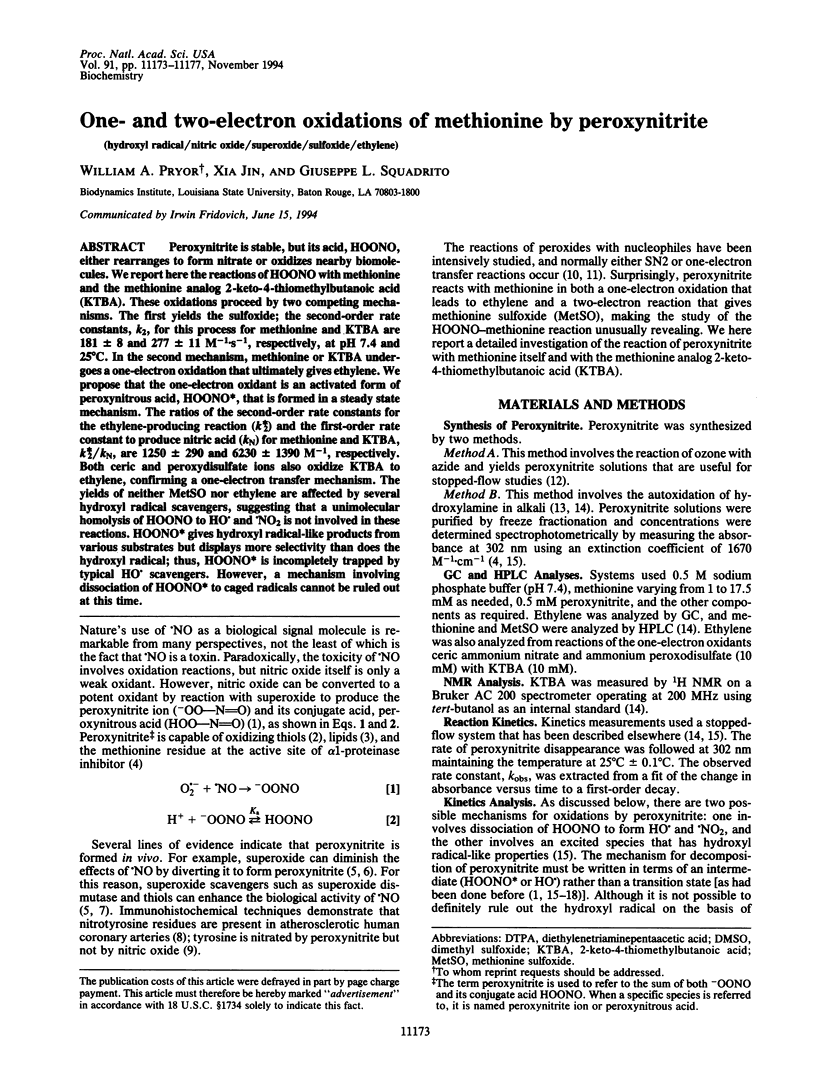
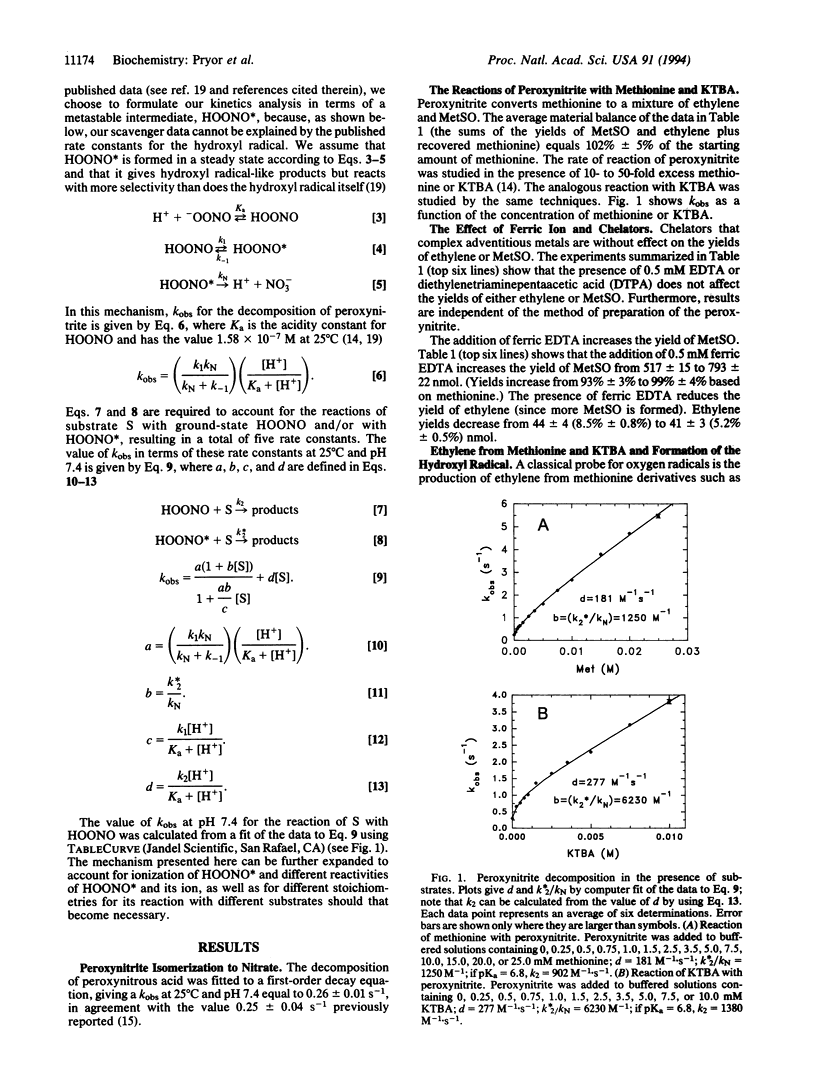
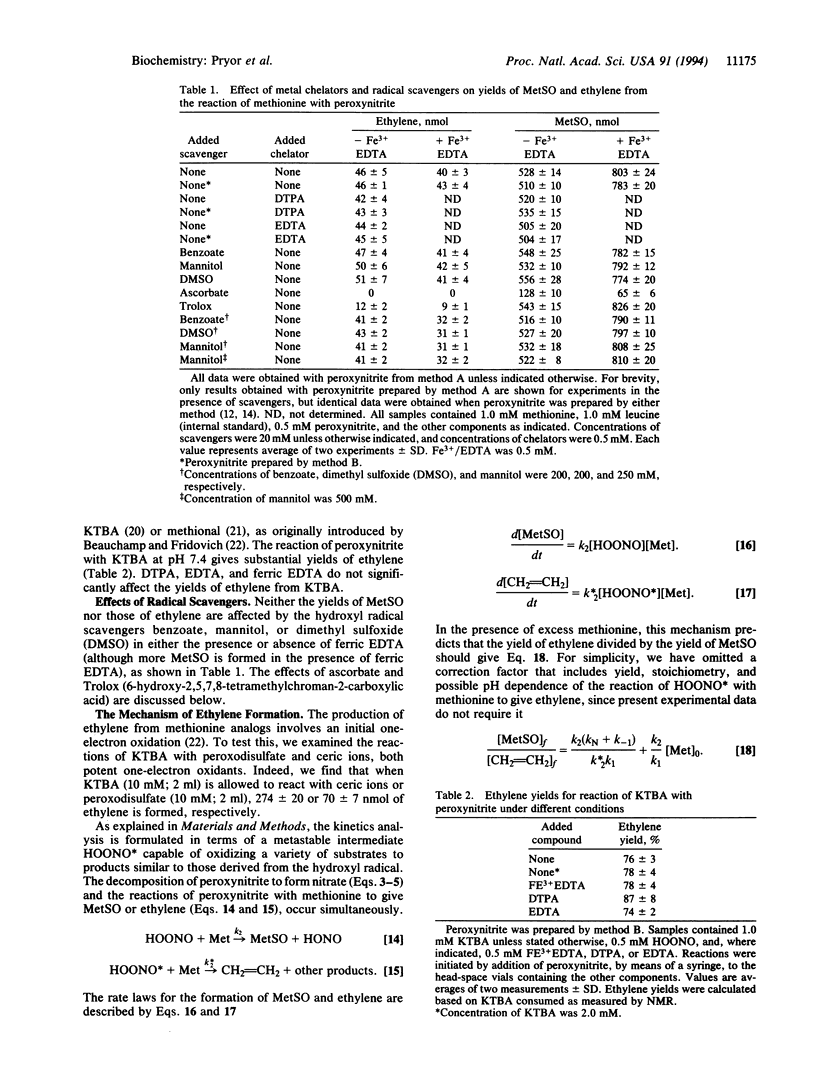
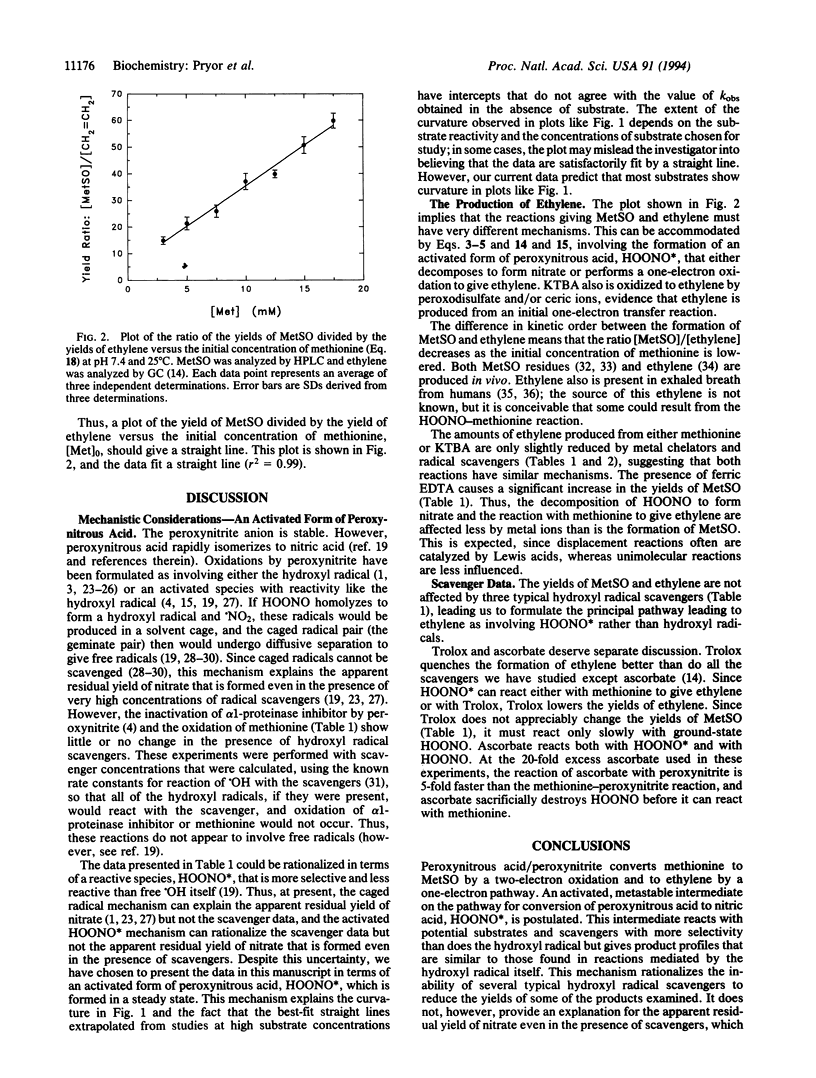
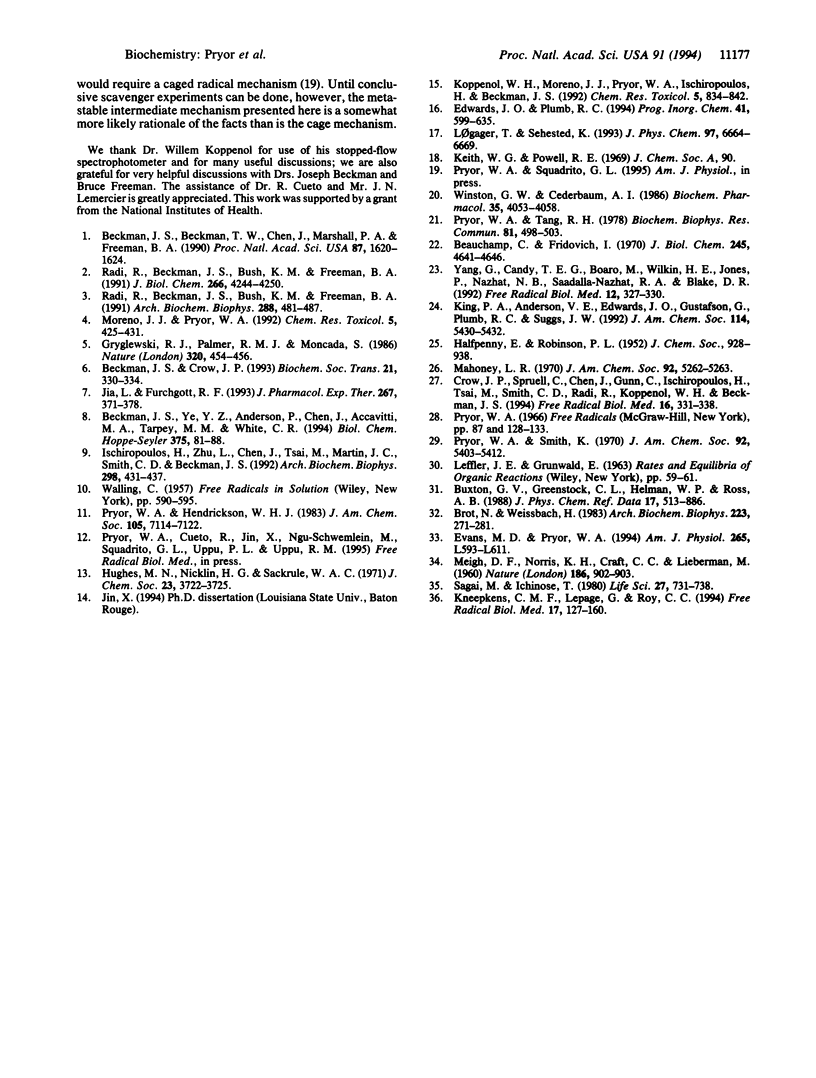
Selected References
These references are in PubMed. This may not be the complete list of references from this article.
- Beauchamp C., Fridovich I. A mechanism for the production of ethylene from methional. The generation of the hydroxyl radical by xanthine oxidase. J Biol Chem. 1970 Sep 25;245(18):4641–4646. [PubMed] [Google Scholar]
- Beckman J. S., Beckman T. W., Chen J., Marshall P. A., Freeman B. A. Apparent hydroxyl radical production by peroxynitrite: implications for endothelial injury from nitric oxide and superoxide. Proc Natl Acad Sci U S A. 1990 Feb;87(4):1620–1624. doi: 10.1073/pnas.87.4.1620. [DOI] [PMC free article] [PubMed] [Google Scholar]
- Beckman J. S., Crow J. P. Pathological implications of nitric oxide, superoxide and peroxynitrite formation. Biochem Soc Trans. 1993 May;21(2):330–334. doi: 10.1042/bst0210330. [DOI] [PubMed] [Google Scholar]
- Beckmann J. S., Ye Y. Z., Anderson P. G., Chen J., Accavitti M. A., Tarpey M. M., White C. R. Extensive nitration of protein tyrosines in human atherosclerosis detected by immunohistochemistry. Biol Chem Hoppe Seyler. 1994 Feb;375(2):81–88. doi: 10.1515/bchm3.1994.375.2.81. [DOI] [PubMed] [Google Scholar]
- Brot N., Weissbach H. Biochemistry and physiological role of methionine sulfoxide residues in proteins. Arch Biochem Biophys. 1983 May;223(1):271–281. doi: 10.1016/0003-9861(83)90592-1. [DOI] [PubMed] [Google Scholar]
- Buchanan C. E., Gustafson A. Mutagenesis and mapping of the gene for a sporulation-specific penicillin-binding protein in Bacillus subtilis. J Bacteriol. 1992 Aug;174(16):5430–5435. doi: 10.1128/jb.174.16.5430-5435.1992. [DOI] [PMC free article] [PubMed] [Google Scholar]
- Crow J. P., Spruell C., Chen J., Gunn C., Ischiropoulos H., Tsai M., Smith C. D., Radi R., Koppenol W. H., Beckman J. S. On the pH-dependent yield of hydroxyl radical products from peroxynitrite. Free Radic Biol Med. 1994 Mar;16(3):331–338. doi: 10.1016/0891-5849(94)90034-5. [DOI] [PubMed] [Google Scholar]
- Evans M. D., Pryor W. A. Cigarette smoking, emphysema, and damage to alpha 1-proteinase inhibitor. Am J Physiol. 1994 Jun;266(6 Pt 1):L593–L611. doi: 10.1152/ajplung.1994.266.6.L593. [DOI] [PubMed] [Google Scholar]
- Gryglewski R. J., Palmer R. M., Moncada S. Superoxide anion is involved in the breakdown of endothelium-derived vascular relaxing factor. Nature. 1986 Apr 3;320(6061):454–456. doi: 10.1038/320454a0. [DOI] [PubMed] [Google Scholar]
- Ischiropoulos H., Zhu L., Chen J., Tsai M., Martin J. C., Smith C. D., Beckman J. S. Peroxynitrite-mediated tyrosine nitration catalyzed by superoxide dismutase. Arch Biochem Biophys. 1992 Nov 1;298(2):431–437. doi: 10.1016/0003-9861(92)90431-u. [DOI] [PubMed] [Google Scholar]
- Jia L., Furchgott R. F. Inhibition by sulfhydryl compounds of vascular relaxation induced by nitric oxide and endothelium-derived relaxing factor. J Pharmacol Exp Ther. 1993 Oct;267(1):371–378. [PubMed] [Google Scholar]
- Kneepkens C. M., Lepage G., Roy C. C. The potential of the hydrocarbon breath test as a measure of lipid peroxidation. Free Radic Biol Med. 1994 Aug;17(2):127–160. doi: 10.1016/0891-5849(94)90110-4. [DOI] [PubMed] [Google Scholar]
- Koppenol W. H., Moreno J. J., Pryor W. A., Ischiropoulos H., Beckman J. S. Peroxynitrite, a cloaked oxidant formed by nitric oxide and superoxide. Chem Res Toxicol. 1992 Nov-Dec;5(6):834–842. doi: 10.1021/tx00030a017. [DOI] [PubMed] [Google Scholar]
- Moreno J. J., Pryor W. A. Inactivation of alpha 1-proteinase inhibitor by peroxynitrite. Chem Res Toxicol. 1992 May-Jun;5(3):425–431. doi: 10.1021/tx00027a017. [DOI] [PubMed] [Google Scholar]
- Pryor W. A., Tang R. H. Ethylene formation from methional. Biochem Biophys Res Commun. 1978 Mar 30;81(2):498–503. doi: 10.1016/0006-291x(78)91562-0. [DOI] [PubMed] [Google Scholar]
- Radi R., Beckman J. S., Bush K. M., Freeman B. A. Peroxynitrite oxidation of sulfhydryls. The cytotoxic potential of superoxide and nitric oxide. J Biol Chem. 1991 Mar 5;266(7):4244–4250. [PubMed] [Google Scholar]
- Radi R., Beckman J. S., Bush K. M., Freeman B. A. Peroxynitrite-induced membrane lipid peroxidation: the cytotoxic potential of superoxide and nitric oxide. Arch Biochem Biophys. 1991 Aug 1;288(2):481–487. doi: 10.1016/0003-9861(91)90224-7. [DOI] [PubMed] [Google Scholar]
- Sagai M., Ichinose T. Age-related changes in lipid peroxidation as measured by ethane, ethylene, butane and pentane in respired gases of rats. Life Sci. 1980 Sep 1;27(9):731–738. doi: 10.1016/0024-3205(80)90326-4. [DOI] [PubMed] [Google Scholar]
- Winston G. W., Cederbaum A. I. Differential effects of the cytochrome P-450/reductase ratio on the oxidation of ethanol and the hydroxyl radical scavenging agent 2-keto-4-thiomethylbutyric acid (KMBA). Biochem Pharmacol. 1986 Nov 15;35(22):4053–4058. doi: 10.1016/0006-2952(86)90027-4. [DOI] [PubMed] [Google Scholar]
- Yang G., Candy T. E., Boaro M., Wilkin H. E., Jones P., Nazhat N. B., Saadalla-Nazhat R. A., Blake D. R. Free radical yields from the homolysis of peroxynitrous acid. Free Radic Biol Med. 1992;12(4):327–330. doi: 10.1016/0891-5849(92)90120-6. [DOI] [PubMed] [Google Scholar]


